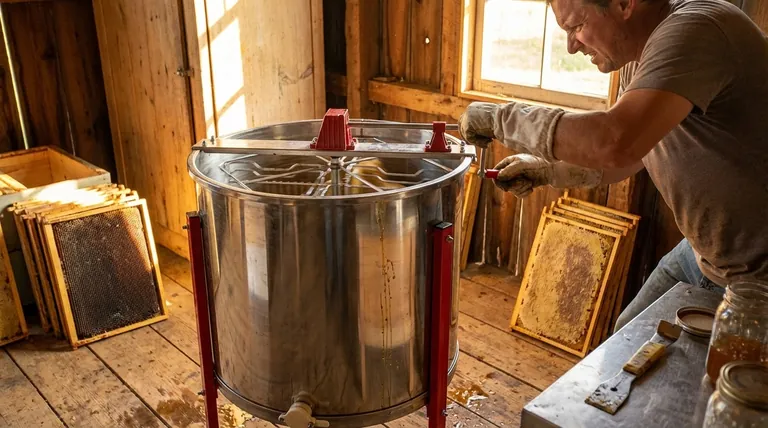At its core, the physical demand of using a manual honey extractor involves the sustained, repetitive effort of turning a hand crank to spin a weighted drum full of honey frames. The exertion is not typically a feat of raw strength but rather one of endurance, requiring a rhythmic cranking motion that can become tiring over multiple extraction cycles.
The decision to use a manual extractor is a direct trade-off: you exchange your own physical energy for a lower initial cost, greater control over the process, and complete independence from a power source.

The Mechanics of the Physical Effort
The primary physical task is straightforward, but several factors determine how demanding it will be. Understanding these variables is key to assessing if a manual extractor fits your needs.
The Core Action: Cranking the Drum
The entire physical requirement centers on the hand crank. You must spin this crank to generate enough centrifugal force to pull honey from the comb. This involves a continuous, circular motion with your arm and shoulder.
Factors Influencing Exertion
The effort is not static. It increases significantly based on the extractor's capacity (a 4-frame extractor is heavier to get started than a 2-frame) and the weight of the honey-filled frames. Achieving and maintaining the necessary speed for full extraction requires consistent physical input.
The Question of "Minimal Effort"
Some describe the effort as minimal, which can be misleading. While the skill required is indeed minimal, the physical energy expended is real. For a single hive's worth of frames, the task is manageable. For multiple hives, it becomes a significant workout that tests your stamina.
Understanding the Trade-offs
The physical demand is the central point around which all other advantages and disadvantages of a manual extractor revolve. It is not simply a feature but the defining characteristic of the user experience.
Endurance vs. Convenience
An electric extractor allows you to load the frames, flip a switch, and walk away. A manual extractor requires your constant presence and physical engagement. The trade-off is your time and energy versus the machine's automated convenience.
Control vs. Automation
The physical connection to the crank provides a tactile experience and precise control. You can feel the weight shift as honey is extracted and can gently ramp up the speed to avoid damaging delicate new comb. This hands-on approach is often preferred by hobbyists who value a deeper connection to the process.
Portability vs. Power Dependency
The greatest benefit of the manual design is its independence. It requires no electricity, making it perfectly suited for use in remote apiaries or off-grid locations. This portability is a direct result of replacing a motor with your own physical effort.
Making the Right Choice for Your Goal
To decide if the physical demands are acceptable, you must align the tool with your specific beekeeping operation and personal capacity.
- If your primary focus is hobby beekeeping (1-4 hives): The physical effort is a manageable and often rewarding part of a hands-on process that offers excellent control.
- If you have physical limitations or plan to expand your apiary: The sustained cranking required for larger harvests can become a significant physical barrier, making an electric model a more practical long-term investment.
- If you must extract honey in a location without electricity: The physical demand is the necessary and worthwhile price for the freedom and portability a manual extractor provides.
Choosing a manual extractor means you are intentionally investing your own energy to gain simplicity, control, and independence.
Summary Table:
| Factor | Impact on Physical Demand |
|---|---|
| Extractor Capacity | More frames = heavier drum, requiring more effort to start and maintain speed. |
| Frame Weight | Honey-filled frames are heavier, increasing the overall load and exertion. |
| Number of Hives | A single hive is manageable; multiple hives require significant stamina. |
| User's Physical Condition | Endurance and shoulder/arm strength directly affect the user's experience. |
Ready to choose the right extractor for your apiary? Whether you're a hobbyist valuing control or a commercial beekeeper scaling up, HONESTBEE supplies durable, high-performance beekeeping equipment to meet your exact needs. Contact our experts today to discuss manual and electric extractors that maximize your efficiency and honey yield!
Visual Guide

Related Products
- HONESTBEE 4 Frame Manual Self Reversing Honey Extractor for Beekeeping
- HONESTBEE 3-Frame Manual Acrylic Honey Extractor
- 2 Frame Stainless Steel Manual Honey Spinner Extractor for Beekeeping
- Stainless Steel Manual 8 Frame Radial Honey Extractor Machine for Beehives
- Stainless Steel 3 Frame Manual Honey Extractor Spinner for Bee Honey Extraction
People Also Ask
- Does honey need to be heated before extraction? The Right Way to Warm Honey for Easy Flow
- What should a beekeeper do after extracting honey from supers? A Guide to Harvest Management
- What is the purpose of decanting in honey extraction? Achieve a Purer, More Stable Honey Product
- How does centrifugation work in honey extraction? The Sustainable Method for Modern Beekeepers
- Why is it important to dry a honey extractor before storage? Prevent Mold, Protect Bees, & Extend Equipment Life



















